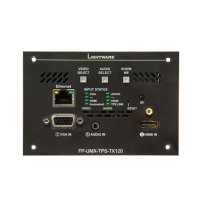UMX-TPS-TX100 series – User's Manual 101
Escaping
DEFINITION: An escape sequence is a sequence of characters that does not represent itself when used
inside a character or string literal, but is translated into another character or a sequence of characters.
Property values and method parameters can contain characters which are used as control characters in the
protocol. They must be escaped. The escape character is the backslash (‘\’) and escaping means injecting
a backslash before the character that should be escaped (like in C language).
Control characters are the following: \ { } # % ( ) \r \n \t
The original message: CALL /MEDIA/UART/P1:sendMessage(Set(01))
The escaped message: CALL /MEDIA/UART/P1:sendMessage(Set\(01\))
Signature
DEFINITION: The signature is a four-digit-long hexadecimal value that can be optionally placed before
every command to keep a command and the corresponding responses together as a group.
number of the lines in the response cannot be determined in advance, e.g. the client intends to receive for the
whole response and also wants to be sure, that the received lines belong together and to the same command.
In these cases, a special feature the ‘signature’ can be used. The response to that particular command will
also be preceded by the signature, and the corresponding lines will be between brackets:
ç
æ {1700
æ
æ
æ
æ
æ
æ
æ }
INFO:
Subscription
DEFINITION:
changes.
the client application up to date, without having to periodically poll the node to detect a changed property.
the node.
ATTENTION! The subscriptions are handled separately for connections. Hence, if the connection is
terminated all registered subscriptions are deleted. After reopening a connection all subscribe commands
Subscribe to a Node
ç
æ
Subscribe to Multiple Nodes
ç
æ
Get the Active Subscriptions
ç OPEN
æ
æ
æ
format of such a message is very similar to the response for the GET command:
æ
A Short Example of How to Use the Subscription
There are two independent users controlling the device through two independent connections (Connection #1
and Connection #2). The events in the rows occur after each other.
ç
æ
ç
æ
ç
æ
ç
æ
æ
Connection #1Connection #2) made a change,
Unsubscribe from a Node
ç
æ
Unsubscribe from Multiple Nodes
ç
æ
Connection #1
Connection #2
Connection #1
}
}

